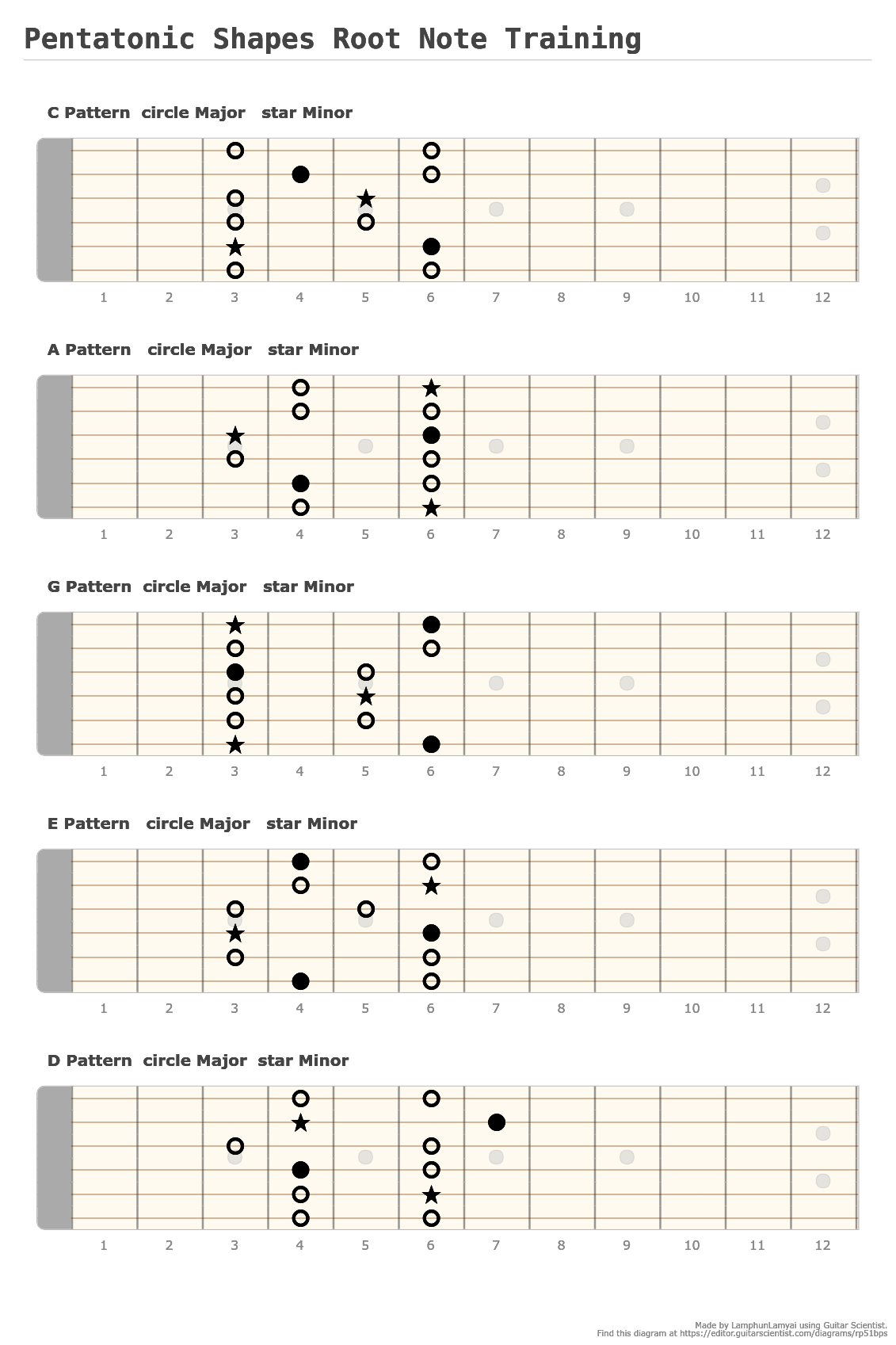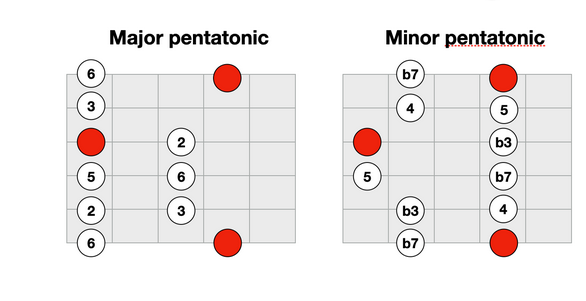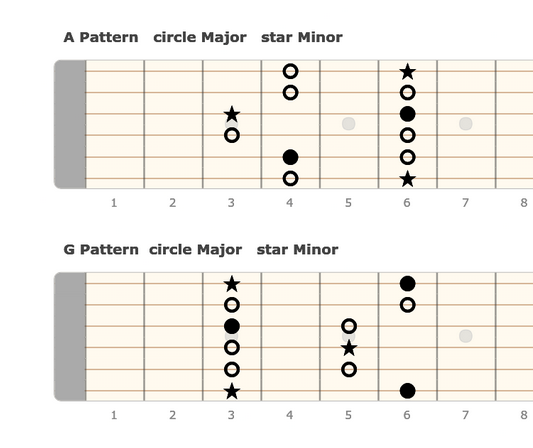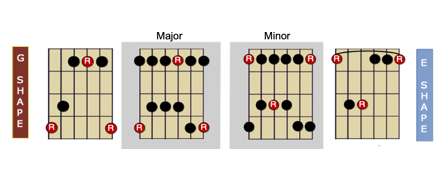Home › Forums › Active Melody Guitar Lessons › Pentatonic CAGED shape “names” seem off vs other sources EP436
- This topic has 32 replies, 10 voices, and was last updated 1 year, 6 months ago by
 Jean-Michel G.
Jean-Michel G.
-
AuthorPosts
-
-
May 22, 2023 at 8:11 pm #343699
loving the CAGED shapes and how we move them around. And loving the mapping of these shapes to the pentatonic scales.
But – it didn’t make sense until I saw them mapped by another source where the “G” shape has the G chord fully included in the shape. Unlike in EP436 where the pdf shows the G shape but has to add extra notes to include the G. It looks like they’re shifted by one.
Let me try and explain with one example;
Here is the pdf https://activemelody.s3.amazonaws.com/lesson_tab_2/pentatonic-scale-5-patterns.pdfNotice that Pattern 1 says E Shape. But to make an open chord in that shape requires adding notes that are not in the pentatonic pattern. I don’t understand why… Other sources just call that the G shape and all the G E D notes from the G chord fit into that shape when it is rooted on the right fret.
I’m sure there is a good reason but it really confuses me that the pdf shows “Shape 1” as the E shape, then the Shape 2 as the D shape (when it perfectly fits the E chord if started on the right fret)
Is it because these are the minor pentatonic shapes?
Basically it is this:
Brian’s naming shapes from the pdf
EDCAG
What makes more sense to me using the same shapes but these names for them
GEDCASorry to add other teachers’ stuff but these are all freely available on google. See these examples and compare what they call the G shape with what is on our pdf as the E shape.
https://www.daddario.com/the-lesson-room/guitar/electric-guitar/play/beginner/lesson-20-guide-to-c-a-g-e-d/
https://www.justinguitar.com/guitar-lessons/major-pentatonic-the-five-patterns-sc-404#:~:text=Pattern%201%20(CAGED%3A%20E%20shape)&text=I%20often%20see%20people%20playing,to%20achieve%20with%20little%20finger.And sorry if this is total heresy for posting on this site but this video totally makes sense of things for me and the shapes all seem to match where no extra notes are needed. And again, what the pdf from Brian calls the E shape is called the G shape and it fits all the notes without adding any extras.
-
May 22, 2023 at 8:49 pm #343700
Hey Jason, great questions and thoughtful analysis. I think you are imagining the major pentatonic shapes over the chords as you describe them. The diagram is the minor pentatonic however. It is superimposed over the major chords from the CAGED system as a way to locate the scales. If you flatten the 3rd in the chords you’ll see a better fit of those minor chords into the minor pentatonic scale. In the diagram, the thirds are mostly the red dots that are not part of the scale. Flatten them a half-step by moving them left (toward the nut) by one fret and notice how nicely they fit into the minor pentatonic scale.
When playing in a major key you generally have the choice of playing the major pentatonic (and sounding quite major) or the minor pentatonic (and sounding more bluesy). So, knowing the major and minor pentatonic locations in relation to the major chords can be helpful. If playing in a minor key however, only the minor pentatonic works well.
Hope this helps! Please ask more questions as they come up.
-
May 23, 2023 at 2:20 am #343710
Hi,
Michael is right; I’ll add that the pdf you show is actually a bit confusing for that very reason. Showing the major chord shapes when talking about the minor pentatonic scales is misleading at best…In the CAGED “system”, there are five major chord shapes; if you take each major chord and flatten the third(s) you get the corresponding minor chord. However, of these five minor chords only three are actually easy to play and practical (Am, Em and Dm).
That being said, the most important aspect of CAGED is the layout (or pattern) of the roots: take any note anywhere on the fretboard, its octaves will always follow that same pattern (but shifted).
So, being able to visualize the location of all the “octaves” of any note using the CAGED roots pattern is the only thing you need. From there, you get any chord shape and any scale (provided you know their definitions, of course). -
May 23, 2023 at 4:07 am #343711
Yeah I think the root is the thing maybe? that other teachers are messing with to change what they call the “E” shape etc and it makes sense.
Let me try to struggle through this and write down my thoughts as I’m thinking it through. Hoping maybe the thought process will help others…
I’m struggling because what Brian is calling the “E” shape made perfect sense somewhere else when it was called a “G” shape. Because the G chord fits perfectly in there with no ‘extra’ notes required.
To call that pattern an E shape requires adding a note that isn’t in the pattern. But why?
Let me try and work that out.
See the attachment I just added. It is the same pattern and has that same A on the 5th fret E strings. . The notes in that pattern include A, C, D, E, & G’s. Are those the notes in the A minor triad? Better check that… Yeah, there are A, C and E in the A minor triad…
So… what is that extra note on the G string 6th fret? (does some finger counting) C-sharp / D-flat
Uh what? Why add that? Just call this a “G” shape and it all fits within the A minor scale.
Ok so I’m still stuck. Why not call that shape the G shape, not add the ‘extra’ note that Brian added and be done with it?
-
May 23, 2023 at 7:30 am #343733
An important thing to realize is that the C MAJOR pentatonic scale and the A MINOR pentatonic scale share the exact same notes. Looking at the “box 1” scale shape at the 5th fret as in the diagram, you can superimpose the C major chord in the G shape, or the A major chord in the E shape. (Or, lower the 3rd of the A chord to make it minor and get a better fit.) Both are correct. Notice that you have the A C E notes of the A min triad in there, and you also have the C E G notes of the C maj triad.
When you play that scale over a C major musical context it sounds very major. Your root notes are the C notes on the first, third, and sixth strings. C major pentatonic.
When you play that scale over an A minor musical context it sounds minor or bluesy. Your root notes are the A notes on the first, forth, and sixth strings. A minor pentatonic.
-
-
May 23, 2023 at 6:23 am #343716
Jason,
Everyone above is correct and I think this is the most useful way to see the fretboard. The key is where the roots are.
CAGED is usually considered the shapes of the major chords. You can create a minor CAGED version like Brian shows here. I think he has done this because the minor pentatonic is often the scale beginners and intermediates are most familiar with.
What happens is that an E minor chord from minor pentatonic box 1 will overlay with an E major chord from box 2 (as Brian labels them) of the major pentatonic.
I think a more useful and cohesive way to look at pentatonic scales and boxes is just to label them by where the roots are, ie. the “E” form, the “D form” etc. and begin to see how the major and minor scales fit around the roots. It’s a great way to think about all scales and modes and to know where you are on the fret board. It’s ultimately the way you will combine major and minor pentatonic in one position or find modal sounds like dorian and mixolydian. It’s a more integrated way of seeing the fret board than the confusing and varying ways boxes and positions are labelled.
John -
May 23, 2023 at 9:33 am #343740
Thanks for all the help everyone. But, I”m still stuck on one thing. It’s just the ‘name’ of the ‘shape’ that is still not letting me go.
The idea that the pentatonic scales align with the CAGED shapes means we have a common language to describe the pentatonic positions. The ‘easy’ pentatonic that goes fingers 4-1, 3-1, 3-1, 3-1, 4-1, 4-1 fits at the nut on the cowboy chord or open chord for G. So we name that the “G shape” pentatonic scale. Well that’s the one on the spreadsheet Brian is calling “pattern 1” but he calls it the “E shape”. So I’m like what? It shouldn’t matter if we’re talking major or minor, that just determines which not of the shape is the root. They’re the same notes. And that easy shape matches the G chord all day long with no ‘extra’ notes needed.
then it goes on up the neck from there with the E shape, D shape etc etc. All makes sense. But why Brian, why is that called the “E shape” on this lesson pdf? To call it E you have to add another note that is not even in that pentatonic. But call it G and everything fits. Was it just a typo by Brian?
Sofa King. Confused.
-
May 23, 2023 at 11:25 am #343754
Why the E-shape? Because in the context of MINOR pentatonic it IS the E-shape.
It is the G-shape when you are looking at it as MAJOR pentatonic. At the 5th fret that is C maj pentatonic over the G-Shaped, C major chord.
But, it is the E-shape when you are looking at it as MINOR pentatonic. At the 5th fret that same shape is the A min pentatonic over the E-Shaped, A min chord. This is what Brian’s diagram is, except he uses the A maj shape at the 5th fret. You can play the A min pent over an A maj chord. Blues all day long…
As John and J-M have stated, the more important info is the root note locations for placing your scale. But, you have to take into account whether you’re talking Maj or Min scale. While Cmaj and Amin share that 5th fret position for box 1 pattern, if you want Cmin pent, you have to move that box 1 pattern up to the 8th fret.
-
-
May 23, 2023 at 10:01 am #343745
Well, a triad is three notes, a pentatonic scale is five notes, a major scale is seven notes… So you should expect a pentatonic scale to contain more notes than a triad, wouldn’t you? And those extra notes won’t belong to the triads – otherwise they would be part of the triad.
I urge you to re-read John’s answer: it best summarizes the whole thing.
a) the names of the CAGED “triad shapes” are based on the positions of the roots in the C, A, G, E and D major cowboy chords (i.e. in first position). That’s pure convention and you should accept it.
As per John suggestion, I’ll use the word “forms” when talking about the layouts of the roots, “shapes” when talking about chords and “patterns” when talking about scales.
b) the only thing that really matters is that zigzag sequence of octaves on the fingerboard (the sequence of the forms).In your last example, we are talking about a pentatonic scale pattern; it can be the C major pentatonic built on the G form or it can be the A minor pentatonic built on the E form.
If you want to extract chords off that diagram, then you have the C chord in G shape (but you have to drop A and D), or the Am chord in E shape (but you have to drop D and G). -
May 23, 2023 at 10:45 am #343750
Get that G form minor pentatonic box 1 out of your head, Jason. The E form is where the E shaped E major chord and the E shaped E minor chord share the same roots. The E form major pentatonic and the E form minor pentatonic scales are going to be different in this position but it is most important to relate them to the root notes. That is how you will best learn to navigate the fret board.
You can also make D, C, A, and G CAGED shapes where each has a major and minor chord sharing roots. Once you understand this concept you can integrate how box 1 minor and box 2 major overlay in the same position
There is another system of nomenclature where box 1 minor and box 1 major pentatonics both start on the same root on the 6th string as it is the first note or root of the scale even though their shapes are different This system resembles calling the position the E form as both pentatonics are sharing the same roots. I think calling box 1 major and box 1 minor when they share the same shape is easier for beginners but is ultimately not a useful concept.
John -
May 23, 2023 at 10:57 am #343751
Final thought, Jason.
The ultimate goal, and probably what moves you toward being an advanced player, is being able to see all the chords of the key (or triads, or arpeggios) in one position on the fret board. You will ultimately do this by being aware of the root notes of each chord in that area as they relate to the CAGED shapes. This will be the key to melodic licks that follow the changes and for voice leading in melody and chord progressions. That is why J-M emphasizes the importance of understanding the “octave system” of the fret board and why I like this concept of E form, D form etc.
John -
May 23, 2023 at 7:53 pm #343773
I think you just have to screw your eyes up and look at it slightly out of focus. Don’t get hung up on inexactitudes, just accept they’re out there, waiting for resolution.
These things are learning tools. Once you know them you don’t need to obsess about this- or that minor exception to the rule.
It’s like learning a new language. English is full of exceptions, German and French too. Not to mention Latin, and Ancient Greek. That’s just how it is.
As a musician, revisit them later and you’ll see everything slightly differently anyway so don’t waste your time diving into too much detail now, just file them away as “interesting” and play your guitar.
-
May 24, 2023 at 12:36 am #343782
Thanks for all the input. I totally get that the same shape can be used for two scales in the same spot.
Like Michael said “An important thing to realize is that the C MAJOR pentatonic scale and the A MINOR pentatonic scale share the exact same notes.”
So if that scale=pattern is the same for both of those keys [C Major and A Minor] and the whole point of the CAGED idea is to learn 5 shapes, then why not call that the G shape all the time whether you’re using it to play the C Mojor or A Minor pentatonic scales? The only difference is the starting point on the scale. The ‘easiest pentatonic shape’ is the one and only “shape” that applies for those two scales on that part of the fretboard and it sure looks like a G shape to me.
Why call it G shape? Well didn’t we learn to call it a G shape in the first place because it maps over G Major at the root? Well then we’re saying its the same shape whether its used for C Major or A Minor in that part of the fretboard. So shouldn’t it just be called the G shape? Why confuse things by calling it a G shape for one scale and a E shape for the other? Then we’d have to learn 10 shape names instead of 5.
Seems like calling that shape G is an incredibly elegant solution. Calling it E forces us to have a weird-looking extra red dot stuck on there that isn’t in the actual scale just so we can map an E chord on top of that scale.
Hope nobody is getting tired of me banging on about this – I’m reading all the responses (except, one by “John” that Jean-Michel said is a must-read… I can’t find one from John). You’re all super smart folks and way better musicians than me for sure. But I think the point I’m making isn’t being heard. It’s the ‘name‘ of the shape that I’m stuck on. It’s a G-shape through and through y’all! G fits that shape like a glove. E doesn’t fit for shi…. you know what I’m saying.
One last thing – If this works how I’m thinking. And so far nothing is seeming off about it. Then I just have to learn 5 Shapes. Call them CAGED and know that if I’m on the G shape that A is before it and E after etc. then learn that if I’m doing a major scale, my root is on x finger in this shape. and if I’m doing a minor scale then the root note is on y finger in the shape. this example, the G shape is followed by the E shape. So that’s what I need to know how to move to next when going up the neck. Same as saying that this shape is the ‘easy shape’ and knowing how to move to the next one up the neck etc. Everyone knows what I mean when I say ‘the easy shape’ right? So shouldn’t we all be saying the same thing when we say ‘the G shape?’
I don’t think I need to know that “this shape is called a G shape if it’s major and it’s called an E shape if it’s a minor key” That’s just too darned confusing methinks.
-
May 24, 2023 at 7:30 am #343796
Jason,
I think I see why this conversation is not getting resolved.
When you consider your “G”shape in 5th position, playing from your index finger gives A minor pentatonic and from the ring finger gives C major pentatonic, the relative scale (relative because they’re the same notes). That’s great if your chords are switching between A minor and C major.
What if you wanted to switch from an A minor pentatonic to an A major pentatonic sound in your 12 bar blues? Now you have to move 3 frets toward the headstock so your pinky is on A to get the parallel major scale (parallel because the roots of the two scales are the same, but the notes are different).
That’s one way to do it but we are talking about playing the A minor and A major pentatonic both in the same 5th position, elegantly called the “E form”. The advantage is that you have made a subtle pleasing to the ear switch with minimal movement and you have the ability to mix the major and minor tonalities together in that one place.
This is why, in Brian’s system, box 2 major pent overlays box 1 minor pent. This overlay is more efficiently described as the “E form” where the roots will give you the parallel scales.
Hope this concept of relative and parallel scales helps clear the issue. I know it created lots of confusion for me in the early days.
John -
May 24, 2023 at 12:03 pm #343809
Jason, sounds like we’re stuck in a semantic loop about the “name” of the pentatonic box shapes. Is it the G-shape? Is it the E-shape? Well, it’s neither: it’s “Pattern 1”.
Just call them box/pattern 1 through 5, which is what Brian usually does. You only need to know 5 patterns, and the names never change. What matters is where you place them over the chords to get the major or minor sound you want. That placement is based on the root notes of the key you’re in. J-M’s diagrams are priceless for this.
So, E-shaped minor chord… ah, I can use Pattern 1 for a minor pentatonic sound over this.
G-shaped major chord… yes, I can use Pattern 1 for a major pentatonic sound.
E-shaped MAJOR chord… I can use Pattern 2 for a major sound, or Pattern 1 for a minor/bluesy sound, or combine them.
etc….(BTW, I’m drawn to this conversation like a moth to the flame. I hope it’s helpful for Jason, and by trying to explain things as clearly as possible it really helps solidify the information in my brain. Thanks to all!)
Oh, and Jason, please look at the A minor chord at fret 5 (E-shape). Notice the perfect fit within Pattern 1, like a glove, no extra notes. Just as good as the G-shape major chord. But, let’s just call it Pattern 1… trying to name it by the CAGED shapes is context-specific and will make us all nuts.
-
-
May 24, 2023 at 1:21 am #343783
Here are two diagrams that should help…
This one diagram shows how occurrences of any given note are laid out on the fingerboard. The top one shows all C’s between the nut and the 14th fret, the one at the bottom shows all A’s. Look carefully at these two examples and notice how that zigzag pattern is actually the same in both cases, but “shifted”. That is what you have to understand and remember if you want to be able to navigate the fretboard.
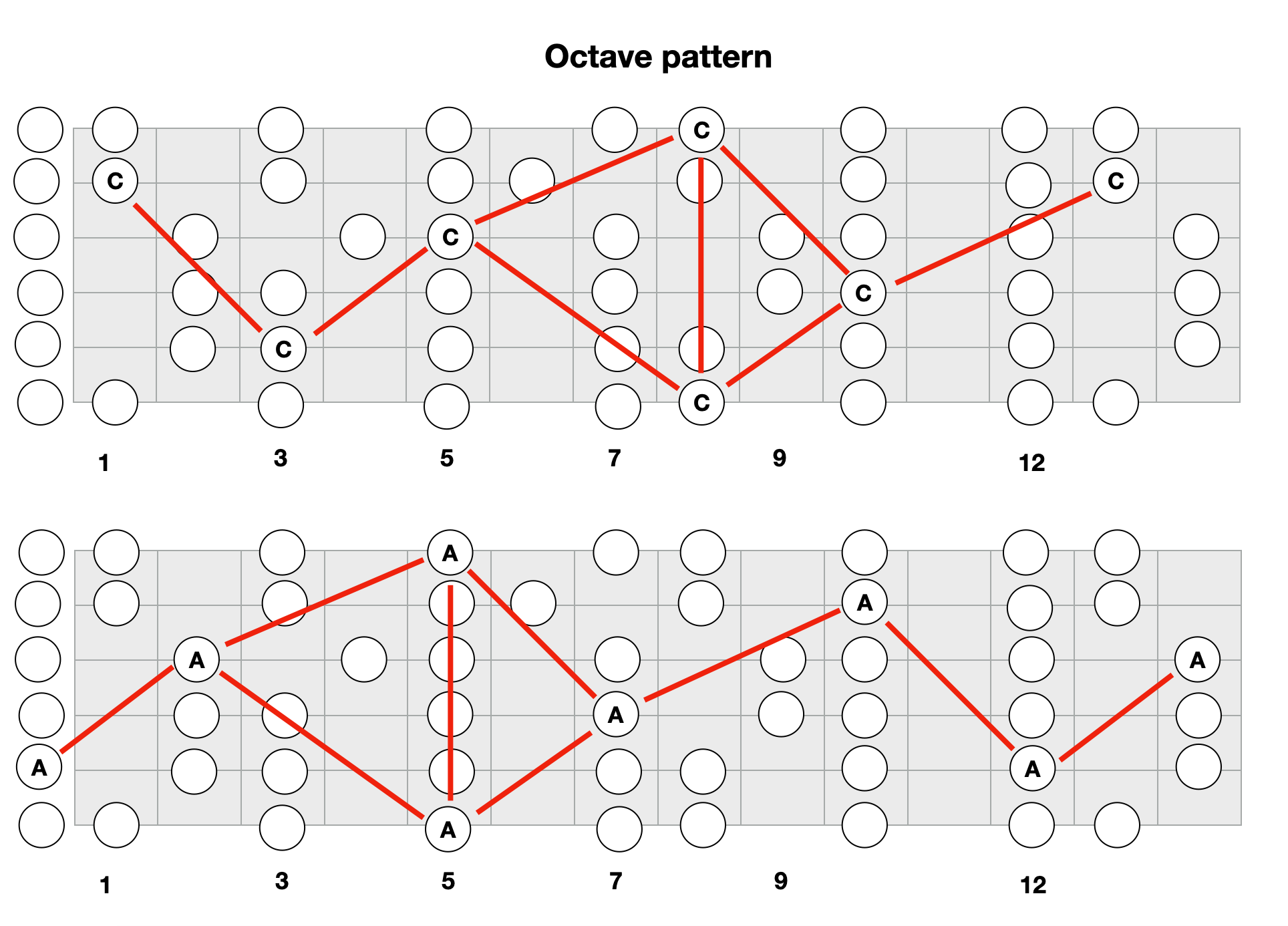
If we cut that pattern into five sections and isolate them, we get the following five “shapes” (or “forms”):
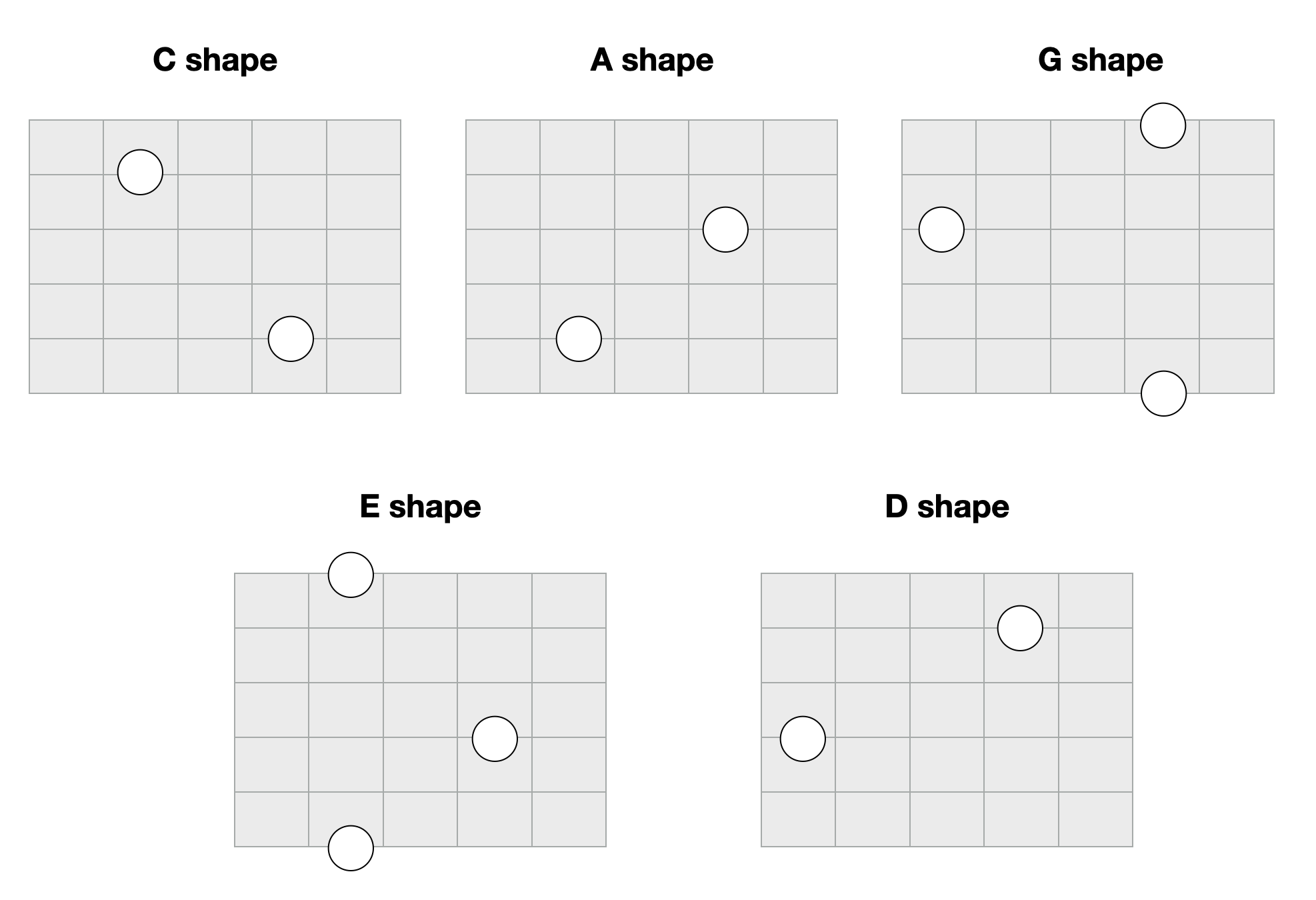
The first one, called “C shape” or “C form” is called that way because is the backbone of a C cowboy triad; the same is true for the other four shapes (or forms).
Please note: the “C shape” will ALWAYS be a C shape, the “G shape” will ALWAYS remain a G shape, etc.
– If you take that “C shape” and consider those two notes to be the roots of a triad, then you’ll have a triad whose name depends on the actual note corresponding to the roots, but whose “shape” will ALWAYS be a C shape. And that triad can be major or minor, it doesn’t matter.
– If you consider the two notes to be the tonics of a pentatonic scale, then you’ll have a scale whose name depends on what that tonic is, but whose shape will ALWAYS be a C shape. Again, the scale can be minor or major, it doesn’t matter: it will always be based on that same “C shape”.
Obviously, if it is a major pentatonic, the other notes will have to be 2, 3, 5, 6 wrt to your tonic; if it is a minor pentatonic, the other notes will have to be b3, 4, 5 and b7 wrt to your tonic.-
March 3, 2024 at 11:08 pm #365061
J-M, I am trying to make sense of the blank white note positions in your C and A octave patterns. I can make out in the C octave pattern that those white dots follow notes for the major scale because I recognize the C major scale pattern (E shape) beginning at the 8th fret C root. But something seems awry on your A octave diagram because when I try to identify the A major scale (again, E shape pattern) beginning at the A root note 5th fret, I see the wrong shape (I see A shape major scale notes). Most likely user error here, so I’m hoping you could shed some light on what I’m missing. Appreciate all the information you’re sharing here.
David
-
March 4, 2024 at 5:58 am #365073
Hi,
I’m not sure I understand your question…
Why do you focus on the E shape? The whole point is that you can use any “shape” as a little framework for scales, arpeggios and chords.If you look at the second diagram with the red zig-zag pattern, you’ll see an A note on the 6th string 5th fret (and also on the 4th string 7th fret and 1st string 5th fret). The A octave notes in the neighbourhood form an E shape; if you play a major scale whose tonic is A in that shape, you’ll be playing an A major scale “using” the E CAGED shape.
If you want to use the same shape to play a C major scale, then you have to shift the whole thing three frets towards the bridge – and you’ll be in the configuration of the first diagram.You can also play an A major scale using the A CAGED shape. For that, you need to place the A note on the 5th string (open) or 5th string 12th fret.
You can also play an A major scale using the C CAGED shape if you start with the pinky on the 5th string 10th fret…
Etc… etc…
-
-
-
May 24, 2023 at 3:18 am #343786
…and one last diagram. I have taken the “G form” that seems to worry you:
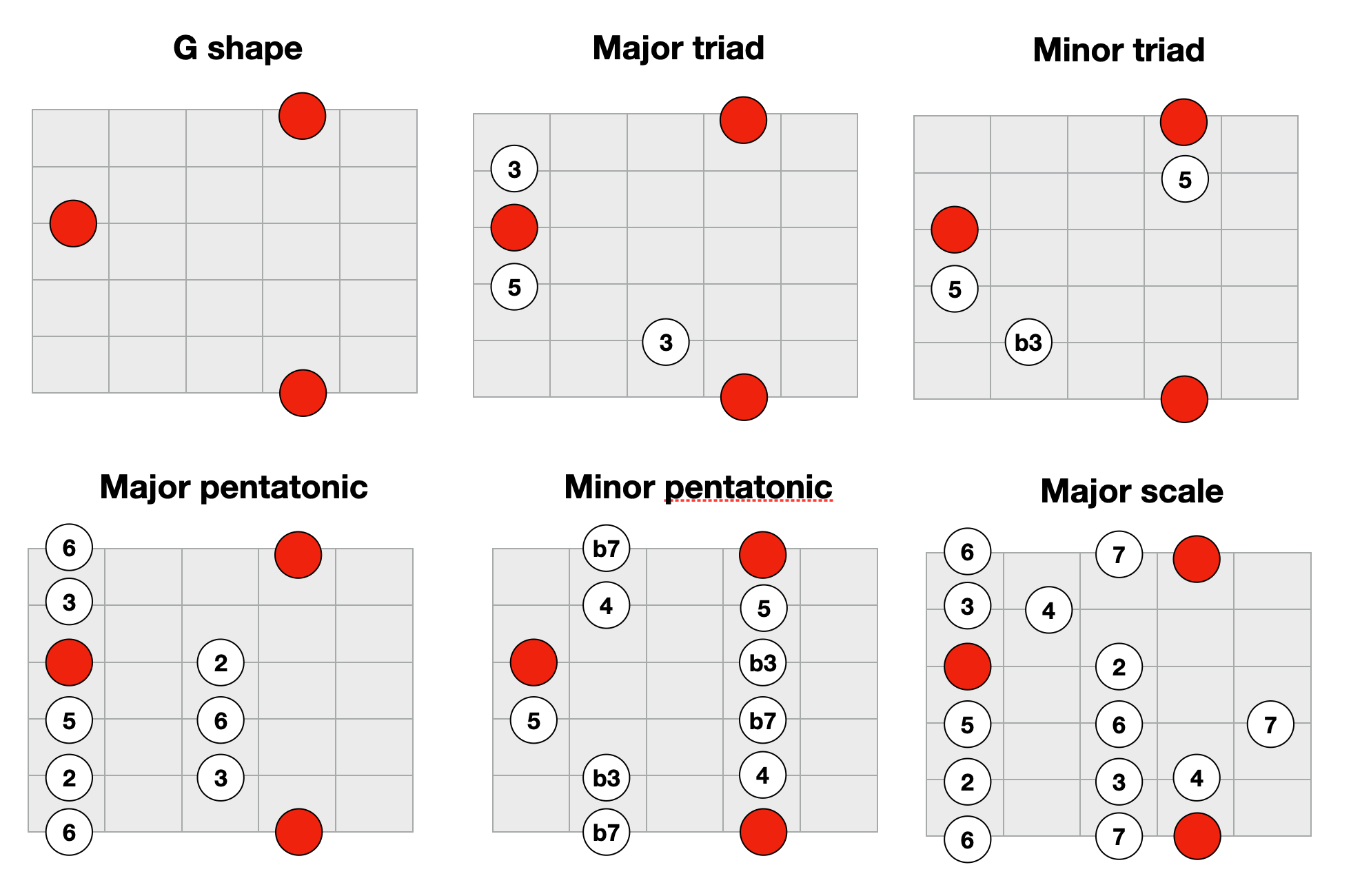
Let’s suppose the red notes are B’s (on the low E string that would put the red note at the 7th fret). We then have a B triad in G form, a Bm triad in G form (not easily playable as such), a B major pentatonic in G form, a B minor pentatonic in G form and a B major scale in G form…
You can (and should) do the same sort of mappings for all the other forms.As long as you don’t change tonic/root, everything will be called “G form something”.
-
May 24, 2023 at 6:44 am #343794
Beautifully illustrated, J-M, and the key to the fret board. Now if you considered a C shape on the 7th fret of the 5th string, you would have the foundation for the IV chord, ie. E or any E scale or mode, all in the same position.
By the way Jason , my name is John, Charjo is my screen name.
John-
May 24, 2023 at 2:05 pm #343812
Now if you considered a C shape on the 7th fret of the 5th string, you would have the foundation for the IV chord, ie. E or any E scale or mode, all in the same position.
Yes, absolutely. I toyed with the idea of adding that bit, but then decided it might just be confusing.
I’ll confess something: I have been playing the guitar for well over fifty years, but there is one thing that I realized only about five years ago… Take any set of six adjacent frets anywhere on the fingeboard; within the span of those six frets you’ll find all the 12 major and minor scales with all their chords and everything! It doesn’t matter whether you’re between frets 2 and 7 or between frets 5 and 10 or whatever. Isn’t that amazing?
…of course, not everything will be easily playable, but as a theoretical concept it very deep.-
May 24, 2023 at 2:40 pm #343814
Fascinating J-M! It’s one think to learn to play this instrument, but who came up with it in the first place? And how? Genius design!
-
-
-
May 24, 2023 at 11:12 am #343807
Yup, that is a great set of diagrams, J-M.
I don’t often see things taught in this framework of a constant root note/position and how the core musical structures lay out relative to that position. It makes so much sense, at least to me.
-
May 28, 2023 at 6:31 pm #343945
Hi All
I think this question, it’s queries etc and the wonderful responses show just what a great friendly resource AM has to offer. Take it or leave it there is great learning to be had by all from those who have contributed here. I think this is one of the best examples I have seen in my many years here. Very well done to all. This degree of query and answer turns on the stadium lights.
JohnStrat -
June 17, 2023 at 11:01 pm #345950
I used Guitar Scientist to create this cheat-sheet which shows the five CAGED pentatonic scales patterns as well as their corresponding Major and Minor root notes within the pattern.
If we memorize the major and minor root note positions in these shapes, you can put it anywhere on the fretboard and understand the major and minor keys for that pentatonic shape. -
June 17, 2023 at 11:37 pm #345953
Obviously, if it is a major pentatonic, the other notes will have to be 2, 3, 5, 6 wrt to your tonic; if it is a minor pentatonic, the other notes will have to be b3, 4, 5 and b7 wrt to your tonic.
Hummm. I got lost right here. Probably because I don’t yet grasp the theory behind it. I’m sure the key to understanding this is right here:
“Obviously, if it is a major pentatonic, the other notes will have to be 2, 3, 5, 6 wrt to your tonic; if it is a minor pentatonic, the other notes will have to be b3, 4, 5 and b7 wrt to your tonic.”I don’t quite know what that means. So I’m lost how we arrive at a minor pentatonic within the G-Shape grouping which looks to be the A-Shape Pentatonic shifted down into the G-Shape root notes – or – it IS the A-Pattern with the corresponding minor root notes. That’s where I’m confused.
Although those two patterns are right here as well if I look at the G-Pattern major root notes and the A-Pattern minor root notes, the two images (above and below) match.
I don’t know if I’m more confused or less confused.
-
June 18, 2023 at 3:07 am #345959
Yes indeed, that’s the key. You have to know and understand the definitions of the scales you play.
By definition, the major scale consists of the following intervals (with respect to the tonic (T)): T 2 3 4 5 6 7 .
To be specific:
– a major 2nd above it
– a major 3rd above it
– a perfect 4th above it
– a perfect 5th above it
– a major 6th above it
– a major 7th above itIf we take A as the tonic, we get the A major scale: A B C# D E F# G# (A)
The major pentatonic scale is by definition: T 2 3 5 6
You can view it as a major scale with 4 and 7 omitted.
Again, taking A as the tonic, we get: A B C# E F#The minor pentatonic scale is by definition: T b3 4 5 b7
Still with A as the tonic: A C D E GForget all those forms, shapes and patterns for a moment, and just concentrate on playing those various scales at different locations on the fingerboard as you see fit! (even on one single string).
You have to know these definitions, and you have to be able to play all those intervals on the guitar.
The “shapes” or “forms” are just a convenient way to play these scales. What matters is where your tonic note is.If you take that “G minor pentatonic shape” above and view it as an A shape, then it means that your tonic is now the b3 of the current form: you have changed tonic!
Yes, it is an “A shape” but with respect to that b3 note.
If the current tonic in your G major shape is the note A, then the b3 is C and so that “A shape” results in a C major pentatonic scale.We are actually back to your original post: within each major shape lives a (relative) minor shape because the notes are the same in the two cases. That’s specific to the major/relative minor relationship.That’s what Michael tried to explain in his answers.
-
June 18, 2023 at 4:39 am #345963
If the current tonic in your G major shape is the note A, then the b3 is C and so that “A shape” results in a C major pentatonic scale.
That should read “If the current tonic in your G minor shape is the note A, …”
-
March 4, 2024 at 7:54 am #365076
Hi,
If you look at the second diagram with the red zig-zag pattern, you’ll see an A note on the 6th string 5th fret (and also on the 4th string 7th fret and 1st string 5th fret). The A octave notes in the neighbourhood form an E shape; if you play a major scale whose tonic is A in that shape, you’ll be playing an A major scale “using” the E CAGED shape.Yes! But the blank white dots do not follow this E shape in the A zigzag diagram, while they do in your C zigzag diagram. The blank white dots are not shifting along with the two zigzag patterns and I wonder why that is. Maybe the white dots don’t mean anything… but I suspect they do.
Sorry, I should have kept my original question simple. I wanted to know the purpose of the blank white dots that you added to your example octave patterns. And then I thought I figured it out, that they are there to map out the major scale notes for all the shapes comprising both those moveable octave zigzag patterns. The E shape checks out for C, but the E shape does not check out for the A octave notes (the white dots there appear to be for pattern 5 of the major scale).
I hope this makes sense. Thanks again for your time.
-
March 4, 2024 at 11:21 am #365084
Okay, I think I begin to see what’s puzzling you…
The two diagrams with the zig-zag patterns represent the actual fretboard and the white circles (all of them!) are the notes of the C major scale (C D E F G A B), for no particular reason. I could have taken the notes of any scale, that doesn’t matter.
The purpose of these two diagrams is to show that, if you pick any starting note anywhere on the fingerboard, all the other occurrences of that same note are always placed according to the same zig-zag pattern. Visually, the zig-zag pattern shifts up and down the fingerboard, depending on the starting note.These two diagrams have nothing to do with scales, or chords or whatever; they just indicate the relative positions of (octaves of) the notes on the fingerboard.
The first of the two diagrams effectively maps all the C notes on the fingerboard; for the note C, the “E shape” happens to be located at the 8th fret.
The second of the two diagrams maps all the A notes; for the note A, the “E shape” happens to at the 5th fret, I.e. three frets lower than for the C note. That makes sense, since A is three semitones lower than C!
Visually, the “small triangle” associated with the “E shape” has shifted three frets to the left (i.e. towards the nut)…
If you map all the B notes, the E shape triangle will be located at the 7th fret.
If you map all the G notes, the E shape triangle will be located at the third fret.Here is yet another way of saying the same thing: pick any fret on, say, the 5th string. No matter what note that is, you are guaranteed to find another same note located two frets higher on the G string, and another one located two frets lower on the B string. The reason for that being that your original note on the 5th string is common to the A shape and the C shape.
I hope this clears things up a bit!
-
-
March 4, 2024 at 12:02 pm #365085
These two diagrams have nothing to do with scales, or chords or whatever; they just indicate the relative positions of (octaves of) the notes on the fingerboard.
I totally get this point… have understood it from the very beginning. It has nothing to do with scales, chords, etc. I have been referring to this very cool visual you prepared for many months now. I love it. Major tool in my binder. I’ve just always had the thought in the back of my mind that for the C octave piece you mapped out the C major scale with those blank white dots, and I periodically would ask myself, I wonder why he didn’t shift those white dots to comply with the A major scale when he mapped the A octave patterns. I began to wonder if I was missing something… theoretically. Seems like I did not miss anything. Thank you for explaining.
-
March 4, 2024 at 8:28 pm #365093
Hi Jason, Interesting thread you have started, good read from all 😊.
1. Yes, it is the Minor Pentatonic, but it is overlayed with major shapes, hence the confusion.
2. Yes it would make more sense to start with the G Shape. The PDF starts at the top with the 5th fret (the E Shape). The emphasis was on that particular pattern. The G Shape is on the bottom of the page. Just ordered differently for that reason.
3. Good resources supplied except the D’Addario example does have an error which includes the B and F note in the Major Pentatonic E shape for C.Attached, the 5 patterns of the Major Pentatonic Scale in the Key of A which aligns with the G,E,D,C,A.
Scott Paul Johnson does have very interesting informative videos. Here he talks about the Major and Minor Relative relationship. Essentially, there are only 5 main patterns. The major pattern when raised 3 frets will give it a Minor pattern. So the G shape on the 2nd fret becomes the E Minor Shape on the 5 fret when using this same pattern in Key A. There are some lessons here on AM about the topic of Relative Major and Minor, just type the topic in the search bar if you want to explore that area further.
-
March 5, 2024 at 1:20 am #365100
I began to wonder if I was missing something… theoretically. Seems like I did not miss anything. Thank you for explaining.
No, I don’t think you missed anything.
The notes on the fingerboard are where they are, they obviously don’t move nor shift.
If you ask yourself: “where are all the G# notes”, you’ll get that zig-zag pattern.
If you do the same for the Db notes, you’ll get the same pattern again, but “sifted”.
For this example, the shift will be huge because the interval between Db and G# is very large (seven semitones).I think showing the notes of the A major scale when mapping the A’s, while showing those of the C major scale when mapping the C’s would be extremely confusing!
As I said, I arbitrarily decided to show the “white piano keyboard notes” because that’s what is often done in music theory, and that’s how people usually learn the notes on the fingerboard.
-
-
AuthorPosts
- You must be logged in to reply to this topic.
